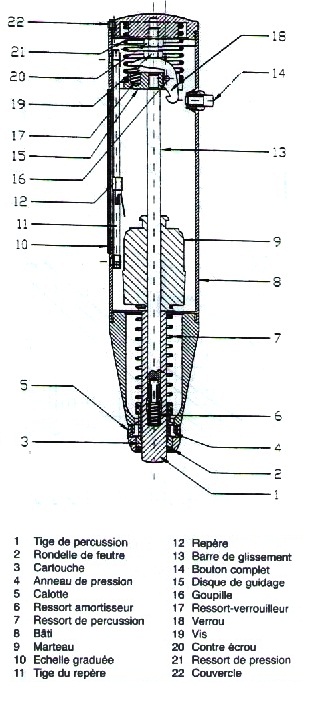Schmidt Hammer on:
[Wikipedia]
[Google]
[Amazon]
A Schmidt hammer, also known as a Swiss hammer or a rebound hammer or concrete hammer test, is a device to measure the 
 The hammer measures the rebound of a spring-loaded mass impacting against the surface of a sample. The test hammer hits the concrete at a defined energy. Its rebound is dependent on the hardness of the concrete and is measured by the test equipment. By reference to a conversion chart, the rebound value can be used to determine the concrete's
The hammer measures the rebound of a spring-loaded mass impacting against the surface of a sample. The test hammer hits the concrete at a defined energy. Its rebound is dependent on the hardness of the concrete and is measured by the test equipment. By reference to a conversion chart, the rebound value can be used to determine the concrete's
Screening Eagle Technologies Schmidt Hammer
''Savoie Maintenance Service revendeur et réparateur SCHMIDT Hammer''
Concrete Geological tools Geomorphology Hardness instruments Nondestructive testing {{geology-stub
elastic
Elastic is a word often used to describe or identify certain types of elastomer, elastic used in garments or stretchable fabrics.
Elastic may also refer to:
Alternative name
* Rubber band, ring-shaped band of rubber used to hold objects togeth ...
properties or strength of concrete
Concrete is a composite material composed of fine and coarse aggregate bonded together with a fluid cement (cement paste) that hardens (cures) over time. Concrete is the second-most-used substance in the world after water, and is the most wi ...
or rock
Rock most often refers to:
* Rock (geology), a naturally occurring solid aggregate of minerals or mineraloids
* Rock music, a genre of popular music
Rock or Rocks may also refer to:
Places United Kingdom
* Rock, Caerphilly, a location in Wales ...
, mainly surface hardness and penetration resistance. It was invented by Ernst Heinrich Wilhelm Schmidt, a Swiss engineer.

 The hammer measures the rebound of a spring-loaded mass impacting against the surface of a sample. The test hammer hits the concrete at a defined energy. Its rebound is dependent on the hardness of the concrete and is measured by the test equipment. By reference to a conversion chart, the rebound value can be used to determine the concrete's
The hammer measures the rebound of a spring-loaded mass impacting against the surface of a sample. The test hammer hits the concrete at a defined energy. Its rebound is dependent on the hardness of the concrete and is measured by the test equipment. By reference to a conversion chart, the rebound value can be used to determine the concrete's compressive strength
In mechanics, compressive strength or compression strength is the capacity of a material or structure to withstand loads tending to reduce size (as opposed to tensile strength which withstands loads tending to elongate). In other words, compre ...
. When conducting the test, the hammer should be held at right angles to the surface, which in turn should be flat and smooth. The rebound reading will be affected by the orientation of the hammer: when used oriented upward (for example, on the underside of a suspended slab), gravity will increase the rebound distance of the mass, and vice versa for a test conducted on a floor slab. Schmidt hammer measurements are on an arbitrary scale ranging from 10 to 100.
Schmidt hammers are available from manufacturers in several different energy ranges, including (i) Type L-0.735 Nm impact energy, (ii) Type N-2.207 Nm impact energy, and (iii) Type M-29.43 Nm impact energy.
The test is also sensitive to other factors:
*Local variation in the sample. To minimize this, it is recommended to take a selection of readings and take an average or median value.
*Water content of the sample; a saturated material will give different results from a dry one.
Prior to testing, the Schmidt hammer should be calibrated using a calibration test anvil supplied by the manufacturer. Twelve readings should be taken, dropping the highest and lowest, and then taking the average of the ten remaining. This method of testing is classed as indirect as it does not give a direct measurement of the strength of the material. It simply gives an indication based on surface properties, and as such is suitable only for making comparisons between samples.
This method for testing concrete is governed by ASTM
ASTM International, formerly known as American Society for Testing and Materials, is an international standards organization that develops and publishes voluntary consensus technical standards for a wide range of materials, products, systems, an ...
C805. A European standard for testing concrete in structures is EN 12504-2. ASTM D5873 describes the procedure for testing of rock.
References
External links
Screening Eagle Technologies Schmidt Hammer
''Savoie Maintenance Service revendeur et réparateur SCHMIDT Hammer''
Concrete Geological tools Geomorphology Hardness instruments Nondestructive testing {{geology-stub